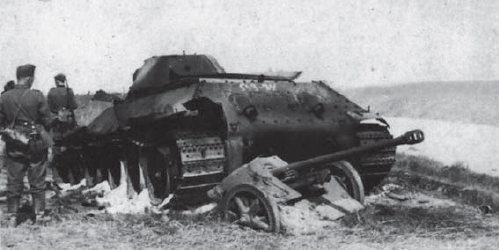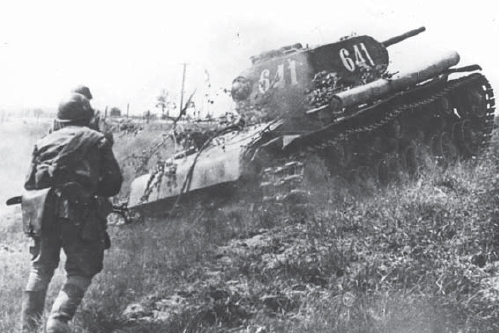
The German Panzerjäger were completely surprised by the KV-1 in June 1941 and were forced to participate in a one-sided duel with it for the next year. The technological assumptions that the Wehrmacht had made about antitank warfare – that the 3.7cm and 5cm PaK would suffice for the time being – proved to be disastrously wrong. Indeed, the German antitank debacle was one of the greatest technological surprises of World War II; far more serious than Allied tank problems dealing with the German Tiger and Panther tanks in 1944. Between June 1941 and May 1942, over 3,600 3.7cm PaK 36 and 350 5cm PaK 38 guns were lost, many crushed under the tracks of the dreaded KV-1 tank. Indeed, 45 percent of the 3.7cm PaKs initially committed to Operation Barbarossa were lost – a staggering degree of attrition. Losses among Panzerjäger crews were equally heavy.

A 5cm PaK 38 run over by a T-34 tank. The German Panzerjäger suffered appalling losses in 1941–42 due to Soviet tank attacks, which often ended with the ineffectual guns being crushed under the tanks’ tracks. (Author)

A 5cm PaK 38 in the streets of Stalingrad. While in its death throes, the trapped 6.Armee managed to knock out a surprising number of KV-1 tanks in the final month of fighting. (Ian Barter)
In comparison, about 900 of the 1,540 KV-1/KV-2s available to the Red Army in the first six months of the invasion were lost, according to Soviet statistics. Based on partial information available from battle reports, it appears that only about 24 percent of these KVs were lost in combat; but 61 percent were abandoned or destroyed by their crews – usually because of mechanical defects or lack of fuel. Early models of the KV also suffered from an appallingly low operational readiness rate – much lower than the T-34. At no point after the first week of the invasion was the Red Army able to mass more than 20–30 KVs in one sector and often only in platoon- or company-size packets. Of the approximately 215 KVs lost in combat in 1941, probably half were knocked out or immobilized by 8.8cm Flak guns or heavy artillery, with the rest falling victim either to antitank mines and point-blank PaK or tank fire. As a general rule, KVs knocked out 3–4 PaK guns before they themselves were knocked out, which suggests that the duel in 1941 saw the loss of about 100 KVs in exchange for 300–400 PaK guns.
Whatever the actual numbers, it is clear that the KV heavy tank overwhelmingly won the duel in 1941, even though logistic problems, lack of training and a variety of other deficiencies prevented the Red Army from capitalizing on the KV’s tactical supremacy. On the other hand, the inability of the German Panzerjäger to overcome the significant numbers of KVs around Leningrad prevented Heeresgruppe Nord from capturing that objective.
In 1942, the duel between Panzerjäger and KVs became something of a race to see whether the Germans could deploy sufficient numbers of heavy PaK guns before large numbers of improved KVs appeared on the battlefield. The Germans won this race by the slimmest of margins, mostly by restocking their Panzerjäger companies with captured French and Soviet weapons and arming them with HEAT ammunition. About 1,200 KVs were lost in 1942 – half of all those built that year. However, far fewer KVs were lost to mechanical defects or fuel shortages in 1942 and the German Panzerjäger destroyed a much larger percentage of them. By late 1942, KVs had lost their battlefield immunity and the balance began to shift in favor of the Panzerjäger.

Soviet infantry advance behind a KV-1S during the summer of 1943. Although the “speedy” model offered better mobility than previous models, it did so at the expense of armor plate and was introduced just as the Germans were fielding their own upgraded Panzerjäger weapons. The net result was to push the KV-1 over the brink from useful heavy infantry-support tank to large, vulnerable, slow-moving target, which hastened its removal from the battlefield. (Courtesy of the Central Museum of the Armed Forces, Moscow via Stavka)
In 1943, the duel was decided in favor of the Panzerjäger once most German divisions received at least a company of 7.5cm or 7.62cm PaK guns. Despite improvements, the KV-1S was still a large, slow target and by mid-1943 the Germans had gained a clear ascendency over the KV, which forced the Red Army to withdraw it from service. Thanks to the Panzerjäger vs KV-1 duel, German antitank capabilities became much greater from 1943 until the end of the war, which would take an enormous toll of Allied and Soviet tankers in 1944–45.
The failure of the KV heavy tank to translate its superior technical characteristics into a decisive advantage is illustrative of the nature of weapons that rely too heavily on one factor. For the Germans, defeating the KV became merely a matter of deploying a weapon with sufficient penetrative power to cancel out the KV’s armor protection. For the Soviets, the KV’s weakness in mobility tended to reduce the value of its armor – lacking the T-34’s maneuverability, the KV often was little more than a mobile bunker.